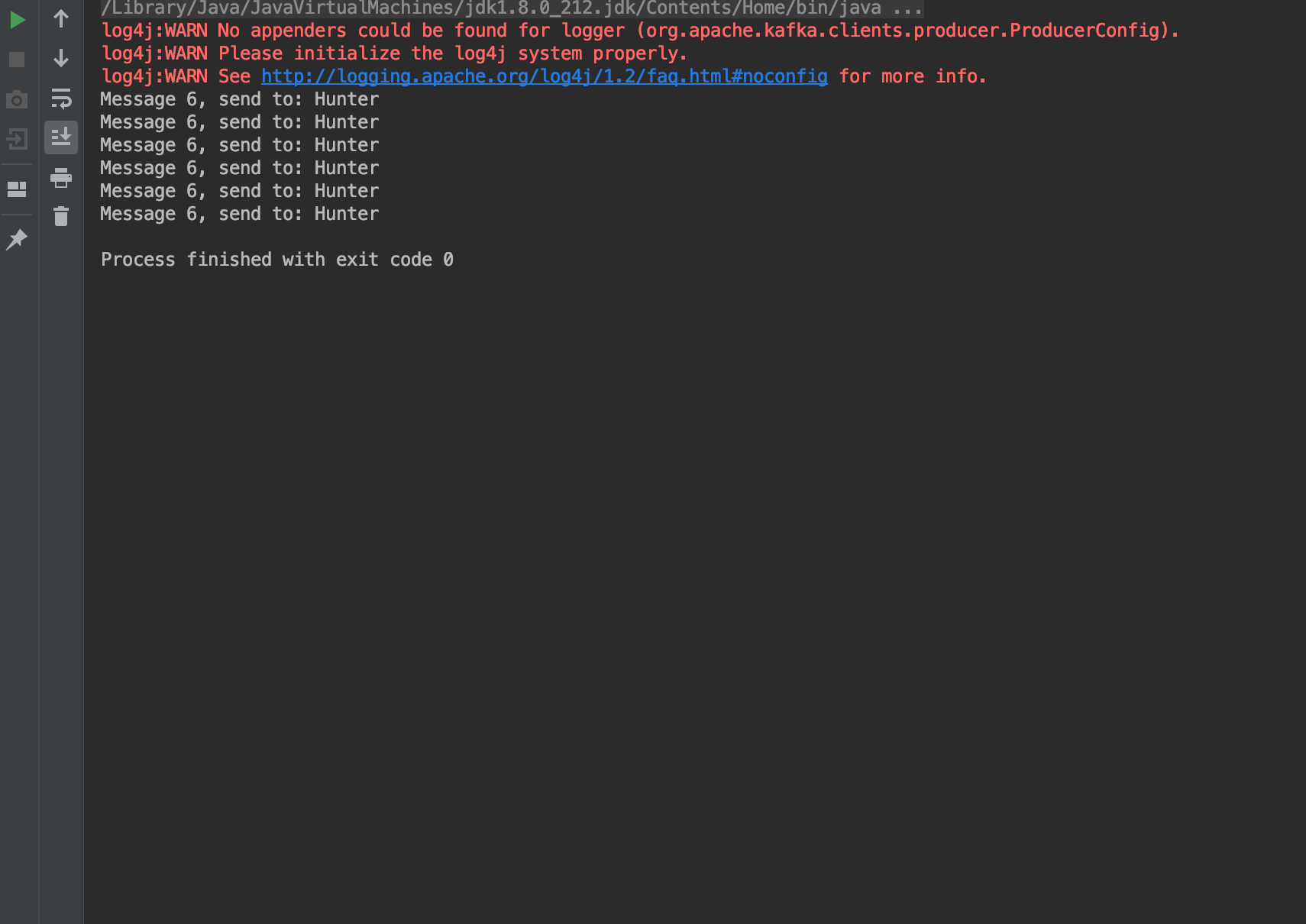一、Spark Streaming
Spark Streaming是核心Spark API的扩展,可实现实时数据流的可扩展,高吞吐量,容错流处理。数据可以从许多来源(如Kafka,Flume,Kinesis或TCP sockets)中提取,并且可以使用以高级函数表示的复杂算法进行处理map,例如reduce,join和window。最后,处理后的数据可以推送到文件系统,数据库和实时仪表板。

二、SparkStreaming实现
Kafka和Zookeeper事先装过,没有先安装Zookeeper,则无法运行Kafka服务。但是,已经为CloudKarafka群集安装并配置了Zookeeper。
我搭建的是 Scala 的 maven 项目,项目和环境都在单机上运行。
1、先看我的 pom.xml 配置:
<?xml version="1.0" encoding="UTF-8"?>
<project xmlns="http://maven.apache.org/POM/4.0.0"
xmlns:xsi="http://www.w3.org/2001/XMLSchema-instance"
xsi:schemaLocation="http://maven.apache.org/POM/4.0.0 http://maven.apache.org/xsd/maven-4.0.0.xsd">
<modelVersion>4.0.0</modelVersion>
<groupId>com.sparkstream</groupId>
<artifactId>LyhSparkStreaming</artifactId>
<version>1.0-SNAPSHOT</version>
<properties>
<spark.version>2.3.3</spark.version>
<scala.version>2.11</scala.version>
</properties>
<dependencies>
<dependency>
<groupId>org.apache.spark</groupId>
<artifactId>spark-core_${scala.version}</artifactId>
<version>${spark.version}</version>
<exclusions>
<exclusion>
<groupId>commons-beanutils</groupId>
<artifactId>commons-beanutils-core</artifactId>
</exclusion>
</exclusions>
</dependency>
<!-- https://mvnrepository.com/artifact/org.apache.spark/spark-streaming-kafka -->
<dependency>
<groupId>org.apache.spark</groupId>
<artifactId>spark-streaming-kafka_2.11</artifactId>
<version>1.6.3</version>
</dependency>
<dependency>
<groupId>org.apache.spark</groupId>
<artifactId>spark-streaming_${scala.version}</artifactId>
<version>${spark.version}</version>
</dependency>
<dependency>
<groupId>org.apache.spark</groupId>
<artifactId>spark-sql_${scala.version}</artifactId>
<version>${spark.version}</version>
</dependency>
<dependency>
<groupId>org.apache.spark</groupId>
<artifactId>spark-hive_${scala.version}</artifactId>
<version>${spark.version}</version>
</dependency>
<dependency>
<groupId>org.apache.spark</groupId>
<artifactId>spark-mllib_${scala.version}</artifactId>
<version>${spark.version}</version>
</dependency>
</dependencies>
<build>
<plugins>
<plugin>
<groupId>org.scala-tools</groupId>
<artifactId>maven-scala-plugin</artifactId>
<version>2.15.2</version>
<executions>
<execution>
<goals>
<goal>compile</goal>
<goal>testCompile</goal>
</goals>
</execution>
</executions>
</plugin>
<plugin>
<artifactId>maven-compiler-plugin</artifactId>
<version>3.6.0</version>
<configuration>
<source>1.8</source>
<target>1.8</target>
</configuration>
</plugin>
<plugin>
<groupId>org.apache.maven.plugins</groupId>
<artifactId>maven-surefire-plugin</artifactId>
<version>2.19</version>
<configuration>
<skip>true</skip>
</configuration>
</plugin>
</plugins>
</build>
</project>
我用的Scala版本是 2.11.8。
2、我的 Producer,代码读取 text1.txt文件中的内容,然后把每行数据发送到 Kafka的名叫 Hunter 的 topic 中,这个名字可以自己改,如果Kafka中不存在这个topic的话,系统会自动创建。text1.txt文件自己创建一个,一行一行的数据就可以,并没什么要求,文件的路径改成自己的。
package KafkaAndStreaming
import java.io.{BufferedReader, FileInputStream, FileNotFoundException, IOException, InputStreamReader}
import java.util.Properties
import org.apache.kafka.clients.consumer.KafkaConsumer
import org.apache.kafka.clients.producer.{Callback, KafkaProducer, Producer, ProducerRecord, RecordMetadata}
object TestKafkaProducer {
type Key = String
type Val = String
def getProducerCnfig():Properties={
/**
* 对于kafka producer的相关配置文件项
* 还有其他的属性,自己去查一下
**/
val props:Properties = new Properties()
// Kafka 的 url
props.put("bootstrap.servers", "localhost:9092")
// group.id 随便写
props.put("group.id", "producer-group")
props.put("replication.factor", "min.insync.replicas")
// 备份数量
props.put("min.insync.replicas", "3")
props.put("key.serializer", "org.apache.kafka.common.serialization.StringSerializer")
props.put("value.serializer", "org.apache.kafka.common.serialization.StringSerializer")
props
}
def main(args: Array[String])={
// 获取配置文件
val props:Properties = getProducerCnfig()
// 创建生产者
var producer = new KafkaProducer[String, String](props)
try{
//读取保存的文件
val fis:FileInputStream = new FileInputStream("/Users/hunter/text1.txt")
val isr:InputStreamReader = new InputStreamReader(fis, "UTF-8")
val br:BufferedReader = new BufferedReader(isr)
var line: String = ""
line = br.readLine()
var i: Int=0
while (line != null) {
producer.send(toMessage(line.toString, Option(i.toString), Option("Hunter")),new Callback {
override def onCompletion(recordMetadata: RecordMetadata, e: Exception): Unit = {
println(s"""Message $i, send to: """ + recordMetadata.topic())
}
})
i += 1
line = br.readLine()
}
producer.close()
br.close()
isr.close()
fis.close()
} catch {
case ex: FileNotFoundException =>{
println("Missing file exception")
}
case ex: IOException => {
println("IO Exception")
}
case _ =>{
println("Have other Error")
}
}
// dealWithData
}
//把我的消息包装成了ProducerRecord
private def toMessage(value: String, key: Option[Key] = None, topic: Option[String] = None): ProducerRecord[Key, Val] = {
val t = topic.getOrElse(Option("test").getOrElse(throw new IllegalArgumentException("Must provide topic or default topic")))
require(!t.isEmpty, "Topic must not be empty")
key match {
case Some(k) => new ProducerRecord(t, k, value)
case _ => new ProducerRecord(t, value)
}
}
}
3、我的 Consumer端,这里主函数启动需要参数,参数为 localhost:9092 Hunter

代码如下:
package KafkaAndStreaming
import kafka.common.TopicAndPartition
import kafka.message.MessageAndMetadata
import kafka.serializer.StringDecoder
import org.apache.spark.{SparkConf, TaskContext}
import org.apache.spark.streaming.kafka.{HasOffsetRanges, KafkaUtils, OffsetRange}
import org.apache.spark.streaming.{Seconds, StreamingContext}
object KafkaAndPrintInSpark {
//判断设置的时输入参数,是否包含brokers 和 topic 至少参数的长度为2,即单机运行一个test的topic: broker=localhost:9092 topic=test
def main(args: Array[String]) {
if (args.length < 2) {
System.err.println(
s"""
|Usage: DirectKafkaWordCount <brokers> <topics>
| <brokers> is a list of one or more Kafka brokers
| <topics> is a list of one or more kafka topics to consume from
""".stripMargin)
System.exit(1)
}
//将参数args读入到数组中
val Array(brokers, topics) = args
// 用2秒批间隔创建上下文
val sparkConf = new SparkConf().setMaster("local[2]").setAppName("DirectKafkaWordCount")
val ssc = new StreamingContext(sparkConf, Seconds(5))
// 创建kafka流与brokers和topic
val topicsSet = topics.split(",").toSet
val kafkaParams = Map[String, String](
"metadata.broker.list" -> brokers,
"bootstrap.servers" -> "localhost:9092",
// "auto.offset.reset" -> "smallest",
"key.deserializer" -> "org.apache.kafka.common.serialization.StringDeserializer",
"value.deserializer" -> "org.apache.kafka.common.serialization.StringDeserializer")
val messages = KafkaUtils.createDirectStream[String, String, StringDecoder, StringDecoder](
ssc, kafkaParams, topicsSet)
// 此处注释部分是自定义偏移量 5L代表从 5开始读取。默认是读取最新的,offset从上一次读取结束的位置开始
// val offsetList = List(("Hunter", 0, 5L))
// val fromOffsets = setFromOffsets(offsetList)//对List进行处理,变成需要的格式,即Map[TopicAndPartition, Long]
// val messageHandler = (mam: MessageAndMetadata[String, String]) => (mam.topic, mam.message()) //构建MessageAndMetadata,这个所有使用情况都是一样的,就这么写
// val messages = KafkaUtils.createDirectStream[String, String, StringDecoder, StringDecoder, (String, String)](
// ssc, kafkaParams, fromOffsets, messageHandler)
messages.foreachRDD( rdd => {
// if(rdd.count()>0) {
rdd.foreach( records => {
println("_1: " + records._1)
println("_2: " + records._2)
})
val offsetRanges = rdd.asInstanceOf[HasOffsetRanges].offsetRanges
rdd.foreachPartition { iter =>
val o: OffsetRange = offsetRanges(TaskContext.get.partitionId())
println(s"${o.topic} ${o.partition} ${o.fromOffset} ${o.untilOffset}")
}
// }
})
// 开始计算
ssc.start()
ssc.awaitTermination()
}
def setFromOffsets(list: List[(String, Int, Long)]): Map[TopicAndPartition, Long] = {
var fromOffsets: Map[TopicAndPartition, Long] = Map()
for (offset <- list) {
val tp = TopicAndPartition(offset._1, offset._2)//topic和分区数
fromOffsets += (tp -> offset._3) // offset位置
}
fromOffsets
}
}
三、最后结果
1、Producer

2、Consumer
